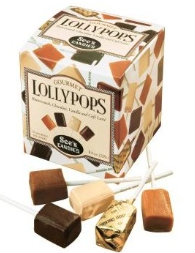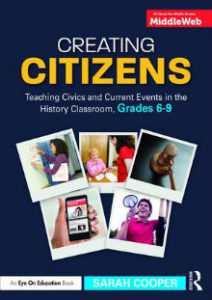A Balanced Approach to Teaching Current Events
A MiddleWeb Blog
 This year I’ve been more careful when choosing the news items I bring into my 8th grade U.S. history classroom daily for our 5-minute current events discussions. Why?
This year I’ve been more careful when choosing the news items I bring into my 8th grade U.S. history classroom daily for our 5-minute current events discussions. Why?
We’ve started a modified block schedule, and I now see my students four times a week instead of five.
On three of those days I bring in a current events article to discuss, and on Fridays three or four students each present a story they’ve chosen and lead a discussion on it.
Although I enjoy random or funny current events stories as much as anyone, I’m now fully aware that my eighth graders are plugged into such pieces through social media memes. We don’t need to spend time on disconnected one-offs.
Current events is becoming ever more of a serious business. Several years ago, I could bring in just about any story without anticipating fallout. Now, if a piece leans too political – and so much seems political right now – it can rub students the wrong way and make them feel less comfortable in my classroom.
Finally, I want articles that do double-duty – that not only illuminate our current world but also do work for my history curriculum.
In other words, any news articles I bring in should be worth the time and potential controversy.
4 Pieces That Passed the “Worth It” Test
Here are some examples from the past couple of months that have passed the “worth it” test in my classroom. I’d be curious to know whether you agree!
1. Personal Connection and Community Awareness
“Frank Gehry Designs YOLA’s New Inglewood Home,” KCRW
Every year on the first day of school, after whizzing through the class guidelines, I discuss a relevant and interesting current event with my students.

This year I chose a piece I’d seen in the LA Times, then found in a podcast. It described a new building for the Youth Orchestra of Los Angeles (YOLA), conducted by LA Philharmonic conductor Gustavo Dudamel and designed by architect Frank Gehry.
I chose the piece for a number of reasons:
• A lot of the eighth graders play instruments, though none of them are in YOLA, an orchestra for low-income students
• Most of them have been to, or at least seen, Gehry’s Disney Hall in downtown Los Angeles, twenty minutes from us without traffic
• The piece incorporated not only architecture and classical music but also football! The new YOLA building will be in Inglewood, a quick drive from the new Rams stadium scheduled to open in 2020.
• In addition, when I looked for a clip of YOLA’s young musicians playing, I hit pay dirt with two minutes from the 2016 Super Bowl, when Dudamel conducted them as backup musicians for Coldplay’s “Viva la Vida.”
• Finally, in 7th grade my students extensively studied the history of Los Angeles, and I knew they would be excited to know the word gentrification in this quotation I played by Gehry: “For me, one of the important things is that YOLA will recruit kids from Inglewood. So it’s not about gentrification. It’s about creating a culture within the community, and that’s special.”
With all of these elements, each student found at least one way to connect to the piece. I hope that the next time they go downtown or attend an LA football game, Gehry’s design for YOLA sits at the back of their minds.
2. Civilized Conversations about Controversial Issues
“Dozens at Facebook Unite to Challenge Its ‘Intolerant’ Liberal Culture,” New York Times
When I scanned through the New York Times on my phone one evening, this piece with a somewhat surprising headline shouted at me for a couple of reasons.
First, the fact that Facebook was in the headline meant that students would identify with the piece immediately. Not because they have their own accounts – come on, these are eighth graders! Right now for them it’s all about Insta and Snap. But they know about Facebook because most of their parents have accounts, and at least half of them recognized Mark Zuckerberg immediately when I showed his photo.
Second, this story gave me the chance to see how much students knew about alleged Russian intervention in the 2016 presidential election, as well as to ask them whether they think it matters that the employees at a social media company lean more in one political direction or another.
Last, and most relevant to discussions about political parties in history during the rest of the year, I relished the chance to show students that liberals could be considered intolerant by conservatives. The majority of our student body skews liberal, and this showed that liberals are not monolithic and that conservative voices need a platform, too.
3. Constitutional Vocabulary and Checks & Balances
“Key Question in Senate Hearings: Would Kavanaugh Overturn Supreme Court Precedents?” Wall Street Journal
A Supreme Court nomination provides the perfect chance to introduce the concept of checks and balances to students who don’t yet know much about the Constitution. As part of our ten-minute discussion at the very start of Kavanaugh’s nomination process, I got to ask and help lay out:
• How many people are on the Supreme Court
• What the two parts of Congress are
• What the executive, judicial and legislative branches are (briefly!)
• What a “nominee” and a “justice” are
• Who nominates the candidate for the Supreme Court
• Which part of Congress approves this nomination

Source: iCivics
As a bonus, a couple of students asked about how many people are in the House and Senate and how they’re chosen, and a few kids also asked about how many women are on the Court.
In eighth grade, which focuses heavily on civics, we will cover all of these topics in more depth later in the year. But how wonderful that we initially arrive at them in the context of relevant, controversial news, which makes them seem even more important!
And I deliberately chose the more conservative-learning Wall Street Journal as the source for this article about a conservative nominee, to try to stay balanced in my classroom “coverage” and to show students an option for a reputable national newspaper that is not the New York Times.
4. Federalism, Term Limits and Climate Change
“How California and China Are Collaborating to Fight Climate Change,” Los Angeles Times
The 2018 midterm elections may feel monumental for the country, and they also feel seismic for California, because we will be electing a new governor for the first time in eight years. In September, current governor Jerry Brown convened a Global Climate Action Summit in San Francisco, in which China was “a key partner.” Brown stirred the pot with his observation that “It’s true I didn’t come to Washington, I came to Beijing.”
When I asked students to brainstorm for two minutes with each other about why it could cause trouble if California conducted talks and possibly negotiated with China on its own, they came up with issues ranging from arguing with the national government (which gave me a chance to teach the word federal) to trying to leave the country (and the word secede). I also mentioned to the students that California has sued the federal government more than three dozen times over the past couple of years and, also, that more than half the states had sued the Obama administration in 2015 over immigration issues.
So much of our year of American history, not least the Constitutional Convention and the 1850s, revolves around the creative tensions inherent in federalism. Having the ability to introduce this topic in a current, relevant and organic way, so early in the year, felt like a wide-open invitation.
Implementing Current Events in Your Classroom
You may be wondering if curating current events requires a lot of morning prep time. It actually doesn’t.
All I do each morning is look at the front section of the Los Angeles Times – while eating breakfast for 10 minutes – which includes listening to my 10-year-old son recite box scores and coordinating schedules for the day with him and my 14-year-old. It’s not exactly uninterrupted time.
Sometimes I’ll also glance at the New York Times on my phone the night before or the morning of class.
And that’s it!
If you teach U.S. history, economics or government, the connections are plentiful. And even if you teach world history, the themes throughout time – power, culture, art, infrastructure – remain the same.
Also, remember that, aside from a few news junkies, most or all of our students will not be as up on the news as we are, even if our knowledge comes from the quick headline-skimming I just described.
If this sounds fun, please let me know what you discover!
___________________________________________________






































Excellent observations! Current events must not disappear once students leave elementary or middle school either. This is foundational civic engagement and community-mindedness. It fosters an awareness of the socio-political spectrum, and informs students that they have voices in a democracy and demonstrates how decisions impact others’ lives, as well.
Thanks for your thoughtful comment, JaDonnia! I love the idea that we need to consistently address current events throughout school and our lives.